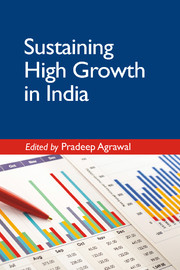Book contents
- Frontmatter
- Contents
- List of Tables
- List of Graphs and Maps
- Preface
- Introduction
- Section 1 Ensuring Macroeconomic Stability for Sustaining High Growth Rates
- Section 2 Promoting Industrial Development for Sustaining High Growth Rates
- Section 3 The International Economic Issues and Sustaining High Growth
- 6 Global Recession and the Eurozone Debt Crisis: Impact on Exports of India and China
- 7 Changing Global Trade Regime and Emergence of Mega FTAs: Strategy for India's External Sector Sustainability
- 8 Economic Impact of Foreign Capital Inflows in Emerging Asia
- 9 FDI Outflows from the BRIC Countries: Impact on Domestic Capital Formation
- Section 4 Infrastructure Bottlenecks to Sustaining High Growth
- Section 5 Some Socio-political Issues in Sustaining High Growth
- List of Contributors
- Obituary
- Index
6 - Global Recession and the Eurozone Debt Crisis: Impact on Exports of India and China
from Section 3 - The International Economic Issues and Sustaining High Growth
Published online by Cambridge University Press: 08 February 2018
- Frontmatter
- Contents
- List of Tables
- List of Graphs and Maps
- Preface
- Introduction
- Section 1 Ensuring Macroeconomic Stability for Sustaining High Growth Rates
- Section 2 Promoting Industrial Development for Sustaining High Growth Rates
- Section 3 The International Economic Issues and Sustaining High Growth
- 6 Global Recession and the Eurozone Debt Crisis: Impact on Exports of India and China
- 7 Changing Global Trade Regime and Emergence of Mega FTAs: Strategy for India's External Sector Sustainability
- 8 Economic Impact of Foreign Capital Inflows in Emerging Asia
- 9 FDI Outflows from the BRIC Countries: Impact on Domestic Capital Formation
- Section 4 Infrastructure Bottlenecks to Sustaining High Growth
- Section 5 Some Socio-political Issues in Sustaining High Growth
- List of Contributors
- Obituary
- Index
Summary
INTRODUCTION
According to Reinhart and Rogoff (2009), financial crises are essentially triggered by a collapse of investor confidence, especially in the case of highly leveraged financial markets. Economists believe that the introduction of more innovative financial instruments aimed at increasing the depth of the markets along with flexible monetary policy could contain the risk of occurrence of financial crises, as these could tackle the underlying business cycle downturns. However, the ‘subprime financial crisis’ that started in the US in 2007 could not be tamed and led to a recession in the largest economy of the world. Further, it snowballed into a global financial crisis, which had a cascading effect on financial markets around the world in 2008 and triggered the ‘Second Great Contraction’ in many economies.
The global recession was extraordinary due to its massive coverage, extreme severity, long duration and huge repercussion effects.
From Figure 6.1a, we observe that the gross government debt of the US was in the range of 60–70 per cent of the GDP till 2007. However, in a bid to revive the economy post the crisis, the US government resorted to fiscal expansion, which worsened the exchequer as the gross government debt soared to more than 100 per cent in 2012–2013. Current account balance (Figure 6.1b) of the US had been deteriorating till 2006. However, due to a dampening of the demand for exports in the face of a recession in the US economy, the current account balance steadily improved since 2007 and now stands at less than 3 per cent of the GDP. Unemployment rate (Figure 6.1c) peaked in the aftermath of the crisis to about 9.6 per cent in 2010, but stood at about 7 per cent in 2013. Figure 6.1d depicts the growth rate of GDP in the US and shows that the growth rate was negative during 2008–2010 and according to the latest data stands at about 2 per cent in 2013. US being the largest economy of the world, the impact of the global recession of 2008–2009 crisis was widespread with several countries of the world tumbling into a recession. This subsequently strained governments around the world as they had to overstretch in an attempt to tackle the real effects of the crisis on their economies by undertaking fiscal expansion.
- Type
- Chapter
- Information
- Sustaining High Growth in India , pp. 177 - 214Publisher: Cambridge University PressPrint publication year: 2017



